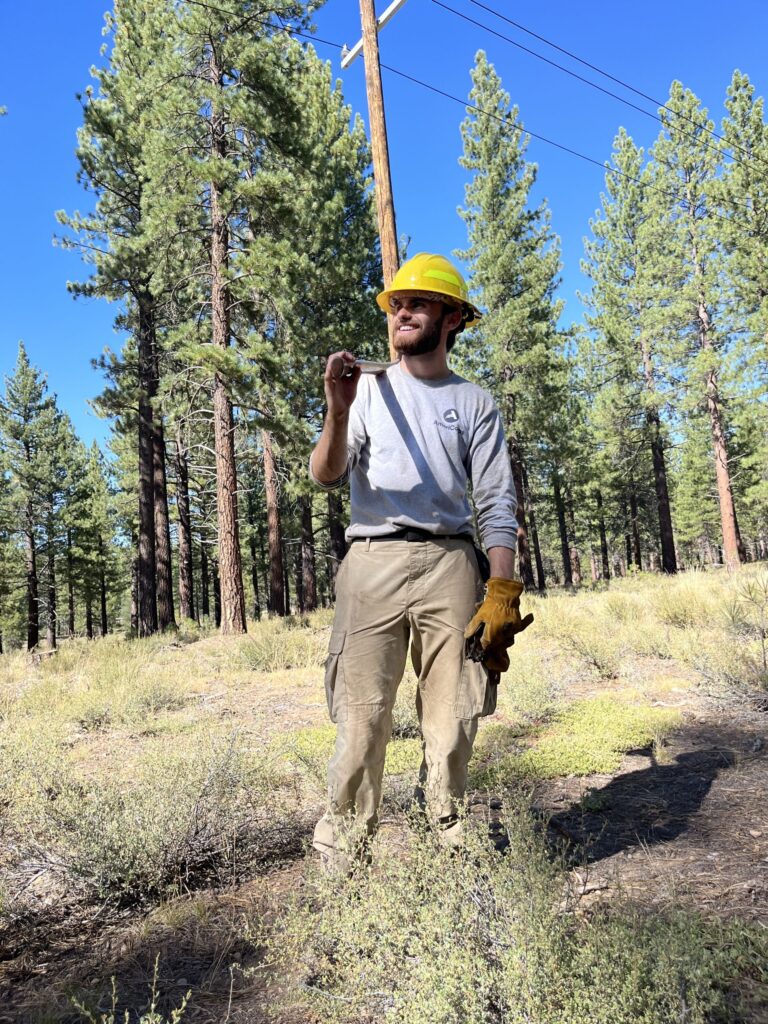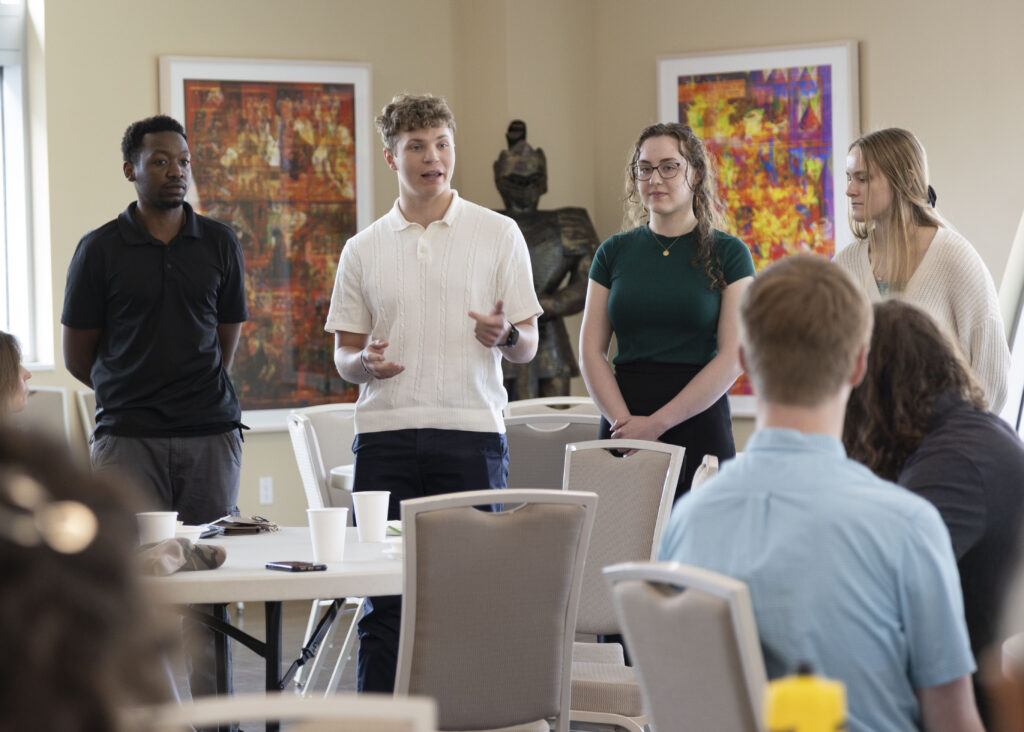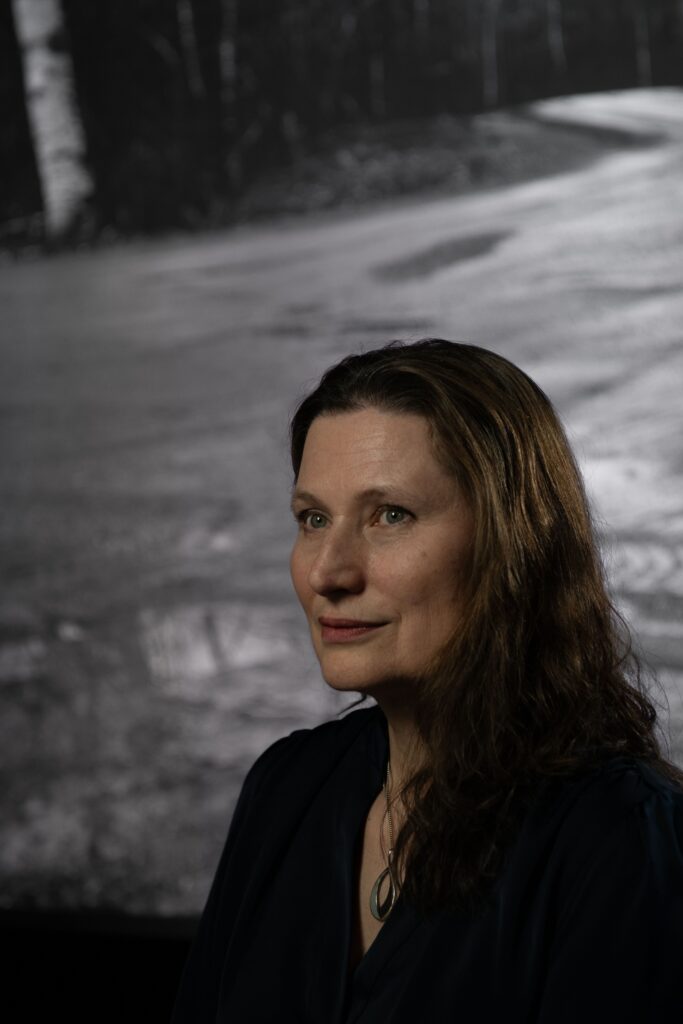Interactive exhibit dazzles with maize

The last crop of corn in the new SMC Natural Area is shown late Saturday afternoon during an interactive exhibit visit there; directly above, artist Amy Pohan and Abenaki Chief Shirley Hook guide students in sampling corn in during the Natural Area/cornfield walk.
An installation at the McCarthy Art Gallery had its interactive performance component on Saturday, September 22 in the form of a guided, meditational meal of corn-based products.
Amanda Turner Pohan’s “Maize Meditation” opened at the gallery on September 6 and will remain on display through the beginning of October. The project is an interdisciplinary examination of the history, science, and sociology of corn. Pohan, based in New York City, aims to get audiences thinking about where their corn comes from and the complex implications of its existence, from the original crop of Native American peoples to the changing crop of European settlers and then, finally, to the mass production and ubiquitous presence of corn-based products in the global West today.
Participants at Saturday evening’s event were seated to sample multiple corn-based foods one by one while Pohan, Abenaki Chief Shirley Hook, and Saint Michael’s biology professor Mark Lubkowitz all offered guidance through their own lenses of expertise. As the artist, Pohan instructed participants to focus on the sensations of eating and the traveling of food through the body, grounding them in the reality of consumption and the ubiquitous nature of corn. Professor Lubkowitz discussed the genetic origins of the corn variety we know today, which still remain uncertain. Chief Hook described the symbolic appropriation of corn, from a central crop of native peoples cultivated by women to a male-dominated agricultural enterprise: a new, western status quo. Even the genetic modification of corn through selective breeding has focused on maximum production and maximum consumption, giving us the large cobs that we know as

A guided corn-related meal in the McCarthy Gallery before the walk.
standard in the twenty-first century. Adorning the table were much smaller corn cobs provided by Chief Hook from the native strain that was returned to the Vermont Abenaki people in 2006.
After the meal, attendees were invited to walk in continued silence from the McCarthy Art Gallery to the corn field in the Saint Michael’s College natural area. The visit served as a goodbye of sorts, and a bitter-sweet one. This fall is the field’s last season of production before the land will be allowed to return to its natural state.
While the artist and speakers acknowledged that the loss of the corn field doesn’t exactly sound inspiring, especially to a crowd surrounded by beautiful golden stalks on the first evening of autumn, they also said that the environmental benefits are clear. No farming means the land won’t be a source of pollution to

Professors Richard Kujawa, Mark Lubkowitz and Brian Collier on the walk. (photos by Danielle Joubert ’20)
the Winooski River. The natural wildlife and foliage of the landscape will have more space to flourish. Best of all, perhaps, are the educational opportunities in store for Saint Michael’s faculty and students alike.
The eager, interdisciplinary response to Pohan’s work is enlightening in its own right, showing the land and the way our bodies inhabit it to be a universal concern. Environmental Studies instructor Trevien Stanger and department Chair Richard Kujawa were also in attendance and ready to answer questions about the field’s future. It is located in the Winooski River floodplain, not far from the bank itself. With time, it is expected to return to wetlands. All
faculty participants anticipate this new living classroom becoming invaluable for Saint Michael’s students, who can study the changing landscape and even help the land gain new life through planting projects and ot

Chief Hook
her environmental initiatives.
Gallery curator Brian Collier of the Fine Arts department, who was critical in bringing Pohan’s work to Saint Michael’s College, expressed the potential for art students to interact with the land in unique ways as well, perhaps drawing inspiration from Pohan’s work. No matter the perspective, Saturday’s events got people thinking about where our food comes from, what it means to occupy that space, and the potentially radical notion of letting it reclaim its own destiny.
“Maize Meditation” is a multi-media installation including audio and video elements. It will be available for viewing at the McCarthy Arts Center until October 6th, 2018.





